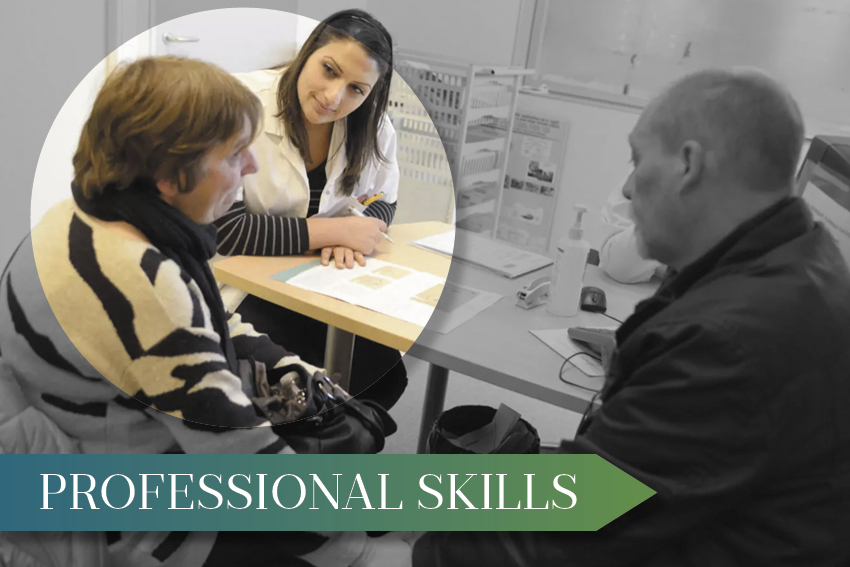
ELIZABETH SCHNEIDER/EURELIOS/LOOK AT SCIENCES/SCIENCE PHOTO LIBRARY
After reading this article, you should be able to:
- Know which behaviours to avoid during difficult situations;
- Understand the professional skills required for effective communication;
- Effectively structure a difficult conversation;
- Apply the techniques detailed in the example audio dialogue to best support patients.
Difficult situations involving patients are a daily occurrence in pharmacy practice. Many healthcare interactions are emotionally charged — patients can be worried, in pain or distressed. If not dealt with effectively, and communication channels break down, challenging and confrontational conversations may occur. For example, the patient may be annoyed about the prescription waiting time or if they received bad news about their health.
Sometimes, all that is required is a brief and simple explanation of the workload in the dispensary, as well as listening to the patient’s concerns and responding appropriately. Pharmacy staff may encounter patients after they have seen other healthcare professionals and may be present when the patient decides to vent. When these situations arise unexpectedly, it can be hard to react and respond in an appropriate manner, especially if they are emotive. Healthcare professionals have reported experiencing anxiety, sadness, empathy, frustration and insecurity when confronted with difficult and challenging conversations and can inadvertently exhibit behaviours (see Box 1) that may not help[1,2].
Box 1: Common communication behaviours to avoid when responding to challenging situations
Blocking — when a patient raises a concern but the healthcare professional fails to respond or changes the conversation, leading to the patient’s most pressing concern not being addressed.
Lecturing — when the healthcare professional provides large amounts of information without providing an opportunity for the patient to respond or ask questions. The patient may be unable to follow the pace of the delivery of information and take it in. The patient may have specific questions but does not get an opportunity to ask. They may also be unable to listen if they are preoccupied with other emotions, such as worry, sadness or feeling overwhelmed.
Collusion — when patients and healthcare professionals avoid discussing sensitive or contentious matters. This is also known as ‘don’t ask, don’t tell’. In these situations, important conversations about prognosis, cure or end of life may not occur.
Premature reassurance — when a clinician responds with reassurance to a patient concern too quickly, without sufficient exploration or understanding of the concern. This can lead to the patient feeling as though they have not been ‘heard’ and that their concern has not been understood or addressed[2].
The demand for care during the COVID-19 pandemic has challenged healthcare professionals, and many have faced conversations that they did not expect or want to have. Through the introduction and presentation of several scenarios, which highlight challenges pharmacy professionals may encounter when in conversation or consultations with relatives or carers, this article outlines best practice for managing them and builds on existing resources developed for the intensive care unit setting, which can be adapted for use in other healthcare settings[3].
Professional skills required for challenging conversations
Several important skills support effective communication in challenging situations (see Box 2).
Box 2: Important communication skills applied during challenging situations
- Active listening (focusing on the patient and what they are saying);
- Appropriate eye contact (being attentive, but not staring);
- Self-awareness of body language (facing the patient and giving your undivided attention);
- Recognising and interpreting non-verbal cues (comparing their non-verbal behaviours to their verbal communication);
- Awareness of barriers that prevent a good exchange between the pharmacy professional and patient (lack of privacy, interruptions, noise);
- Avoiding jargon.
Additional articles covering pharmacy consultation and communication skills can be found here.
Pharmacy professionals should show empathy by thinking about how the patient may feel in their situation, and showing respect, while acknowledging and addressing patients’ fears and encouraging them to express themselves. Pharmacy professionals should understand how to manage their emotions, recognise how these affect thoughts and behaviours, and understand, appreciate and interact with people from cultures or belief systems different to their own[4]. To have conversations with patients about their medicines and conditions, pharmacy professionals need to possess the relevant clinical knowledge to provide an appropriate explanation and have an effective consultation.
Effective teamwork within the multidisciplinary team (MDT) is essential, alongside an awareness of professional limitations, referring to others where appropriate[5].
Structuring difficult conversations
A five-step approach known as ‘the five A’s’, outlined below, provides a practical approach to structuring challenging conversations[6].
Step 1: Ask the patient what they want from the consultation. Identify their concerns and do not assume what they want. Give the patient your full attention and listen to their answers.
Step 2: Acknowledge the patient’s situation to demonstrate that you have taken their issue on board. Do not judge the patient, even if they express views or opinions you do not agree with.
Step 3: Address any concerns the patient raises honestly, clearly explaining what you can do to help, even if this is not exactly what the patient wants. Identify potential problems and discuss their management. When working towards solutions, ask the patient what ideas they have and then offer suggestions, signposting and support.
Step 4: Accept the patient’s decision. If they have made a decision you do not agree with, make sure they have understood the risks and benefits, but be careful not to judge them. This ‘leaves the door open’ for future conversations.
Step 5: Agree actions. Ask the patient to explain what they are going to do, how they will put that in place and reiterate what has been agreed. Agree a specific follow-up plan, how this will be communicated to other relevant healthcare professionals and what to do if problems arise before the scheduled follow-up[6].
Handling a situation with the right tools can reduce the impact of a difficult situation for both the patient and the pharmacy professional[7]. It is important to remember that people want sincerity and honesty; they want to be respectfully listened to, with their situation acknowledged and addressed in a timely manner. The COVID-19 Communication Playbook from Vital Talk provides a practical guide on how to talk about difficult topics to help with empathy and compassion in response to the COVID-19 pandemic[3].
Clinical scenarios
The clinical scenarios and example dialogue below demonstrate common challenges that pharmacy professionals can face when consulting with patients, and outline how to best manage the situation. All examples are derived from cases from the authors’ experiences and do not relate to any specific patients.
Scenario 1
Mr “MV”, a male aged 58 years, is admitted to hospital to have a metallic heart valve replacement. He is started on warfarin after surgery, which he has been told he will be on long term. He is apprehensive about this new medication and upset that he was not involved in the decision making when it was started on the ward.
Comment: When asking questions, it is important to balance sensitivity with clarity and honesty. Address the patient’s questions directly and do not avoid them. Provide facts tailored to the patient’s needs, remaining sensitive to their feelings. Discuss next steps with the patient and ask the patient to describe their next steps, to check their understanding.
Scenario 2
Mr GR, a male aged 78 years, was admitted to hospital following a fall at home. On examination in A&E, he had crackles in the base of both lungs and a slightly raised temperature. He was moved after midnight to an older people’s ward. He is hard of hearing and appears distressed. He is told he is not allowed to get out of bed and must use the buzzer to call the nurse. He sees a nurse walking by.
Comment: When acknowledging a patient’s feelings, be aware that patients may need time to express their frustration or anger. You may need to apologise where appropriate. Always ask what they want (if they have not told you) and offer honest, realistic solutions within your control.
Scenario 3
Mr AD, a male aged 97 years, with a background of COPD, diabetes and heart failure was presented to A&E with an acute exacerbation of his COPD by his grandson as his main carer. Mr AD developed upper respiratory symptoms, fever, dry cough, severe wheezing and worsening dyspnoea 12 days ago. The COVID-19 polymerase chain reaction swab performed was positive and he was diagnosed with COVID-19 pneumonia; however, he did not fulfil the criteria for intensive care unit (ICU) admission and was medically assessed to receive palliative care.
Comment: Empathy is more than words. You can show empathy in your posture and the way you interact with someone when acknowledging their situation. But during the pandemic it has been difficult to show empathy, particularly when wearing personal protective clothing. In this case, maybe the words you use will have more meaning. Listening and showing you are listening, acknowledging their concerns/distress with an empathic response will have a better outcome. Slowing down, using silences and softening your voice will help to establish a bond of affection and respect. Before ending the consultation, check their understanding, summarise what you have said and ask if they have any questions. More information on how to apply the principles of empathy effectively during consultations can be found here.
Scenario 4
Mrs OP has had a recent hip fracture and was recently discharged from hospital. She has read about teriparatide, a new treatment for osteoporosis. She was taking bisphosphonates before her fracture, but now wants the “new expensive treatment” as the current one is “cheap” and clearly does not work. She goes to see the pharmacist in her surgery to talk about her medicines.
Comment: Conversations do not always end on a positive note or with a resolution. We may not agree on a way forward. It is important to accept that this can happen and rather than “agree to disagree”, focus on respecting the patient’s choice, even if it is different to the one you would have made/recommended. Reassure the patient/relative that their concerns are being taken seriously and escalate when required[4].
Self-care and supporting others
The NHS recognises that it is especially important for us to look after ourselves and each other.
It is easy to think that we are immune to the emotional impact of difficult conversations, especially during the COVID-19 pandemic, but undertaking the following activities may help:
- Regularly checking how you are feeling;
- Acknowledging that it is OK not to be OK;
- Sharing your experiences with colleagues;
- Talking to someone you trust;
- Helping others;
- Taking time to rest, relax, sleep and enjoy meals.
Managers may need to provide their team with help and reassurance when faced with these situations. Box 3 provides some examples of the type of questions a staff member might ask their manager, and provides example responses and links to useful resources and organisations.
Additional information on ways to promote self-care for you and your team during COVID-19 can be found here[8].
Box 3: How to provide support and reassurance to others
Question: “I feel like I am not able to give the patient what they need, how do I cope with this?”
Response: “We work in a system supported by national guidelines. Sometimes that means that what is best for the system is not always ideal for the individual. It is hard to accept this when you are dealing with one case at a time.”
Statement: “I am afraid of burnout.”
Response: “It is very common for people to feel like this after repeated difficult conversations. Can you look for moments every day where you connect with someone, share something, enjoy something? It is possible to find little pockets of peace.”
Statement: “I am worried that I will be overwhelmed and won’t be able to do what is best for my patients.”
Response: “When you are faced with managing difficult situations, it’s easy to feel overwhelmed. Take a moment to check your own state of being. If one extreme is feeling wiped out and the other is feeling strong, how do you feel now? Remember that whatever your own state, it is normal to sometimes feel this way but it is important to take note of how you are feeling in order to determine what’s best for you and the next best course of action.”
- 1Martin EB Jr, Mazzola NM, Brandano J, et al. Clinicians’ recognition and management of emotions during difficult healthcare conversations. Patient Education and Counseling. 2015;98:1248–54. doi:10.1016/j.pec.2015.07.031
- 2Back AL, Arnold RM, Baile WF, et al. Approaching Difficult Communication Tasks in Oncology. CA: A Cancer Journal for Clinicians. 2005;55:164–77. doi:10.3322/canjclin.55.3.164
- 3COVID ready communication playbook. VITALtalk. 2021.https://www.vitaltalk.org/guides/covid-19-communication-skills/ (accessed Nov 2021).
- 4Allinson M, Chaar B. How to demonstrate empathy and compassion in a pharmacy setting. The Pharmaceutical Journal. 2019.https://pharmaceutical-journal.com/article/ld/how-to-demonstrate-empathy-and-compassion-in-a-pharmacy-setting (accessed Nov 2021).
- 5McDonough RP, Bennett MS. Improving Communication Skills of Pharmacy Students Through Effective Precepting. Am J Pharm Educ. 2006;70:58. doi:10.5688/aj700358
- 6Barnett N. Improving pharmacy consultations for older people with disabilities. Journal of Medicines Optimisation 2016;2:72–76.https://www.pharman.co.uk/uploads/mediacentre/JOMO_December_2016.pdf
- 7Bailey S. Seven steps for having difficult conversations . American Nurse Journal 2021;16:14–16.https://www.myamericannurse.com/wp-content/uploads/2021/04/an4-Conversations-315.pdf
- 8Kam A. Five ways to promote self-care for you and your team during COVID-19. The Pharmaceutical Journal. 2020.https://pharmaceutical-journal.com/article/feature/five-ways-to-promote-self-care-for-you-and-your-team-during-covid-19 (accessed Nov 2021).


